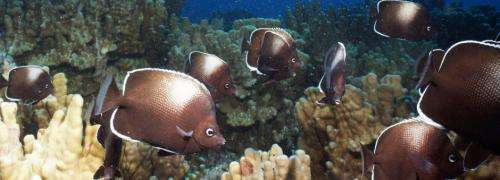Researchers study marine ecological changes at Easter Island

Easter Island is the most remote inhabited island in the world, roughly 1,900 miles from the Chilean coast. It's also near the southern limit of the range in which corals can thrive. Its extreme isolation has yielded a marine community with relatively few species and extremely high rates of endemism.
Despite its isolation, there has been profound change in recent decades. In the 1980s, fishermen and recreational divers reported a major regime shift from an algae-dominated state (primarily Sargassum) to a coral-dominated state.
"It is unclear what prompted this shift," said Robert Lamb, an ecology and evolutionary biology graduate student at Brown. "A change in oceanographic conditions facilitating coral recruitment and growth? A change in coral larval supply? A change in consumer pressures?"
Jon Witman, professor ecology and evolutionary biology, added that he sought to determine how the small regional species pool and isolated oceanographic position of Easter Island might influence these changes. "This was a central focus of our research, since coral reefs around the world are currently in decline, whereas reefs at Easter Island appear to have been increasing in coral cover for the last several decades."
To try to answer these questions Witman and Lamb traveled to Easter Island from Nov. 15 through Dec. 5, 2014, on a research project led by professor Evie Wieters of the Universidad Catolica de Santiago de Chile. Witman sampled the diversity of coral-dominated communities on vertical walls to place the marine biodiversity of Easter Island in a global context and to begin studying the local (urchin grazing) and regional (number of species in the biogeographic region) processes responsible for low diversity there.
The isolated ecosystem is susceptible to extreme events such as El Niño, as well as human impacts such as over-fishing. Importantly, Lamb said, there are no connected populations to revitalize the community after a decline.
Witman said he has never seen so much open space (bare rock) in this type of community, which could reflect either the low number of invertebrate species in the region or intense grazing from sea urchins.
Some of the evidence Witman and Lamb saw suggested that the urchins, voracious herbivores and grazers, are largely responsible for the predominance of bare rock where corals are absent. They eat the algae that might otherwise compete with coral.
They observed that the urchins appear to line up like soldiers on the front of a battlefield, advancing into the algal bed. "If we imagine their slow movements sped up hundreds of times, we would see the line advancing into the algal bed," Lamb said. "Urchins don't appear to cross the algal line, perhaps because they can become dislodged by waves if their flimsy tube feet are attached to slippery substrates such as algae and sand. Thus, the front advances slowly, allowing corals to colonize the bare rock left behind."
The Witman lab assisted Weiters' team to test this idea with experiments in which they set up the interaction to see what would happen. By their design they could examine the relative importance of structure (corals vs. no corals) and substrate (algae/sand vs. bare rock) in determining urchin feeding behavior, and they could see whether or not new feeding fronts can be established inside of algal-dominated areas, Lamb said.
Their research will help explain how the marine communities of this remote and famous island will respond to changes in climate and diversity.
Provided by Brown University


















